Biermann Ch. Handbook of Pulping and Papermaking
Подождите немного. Документ загружается.

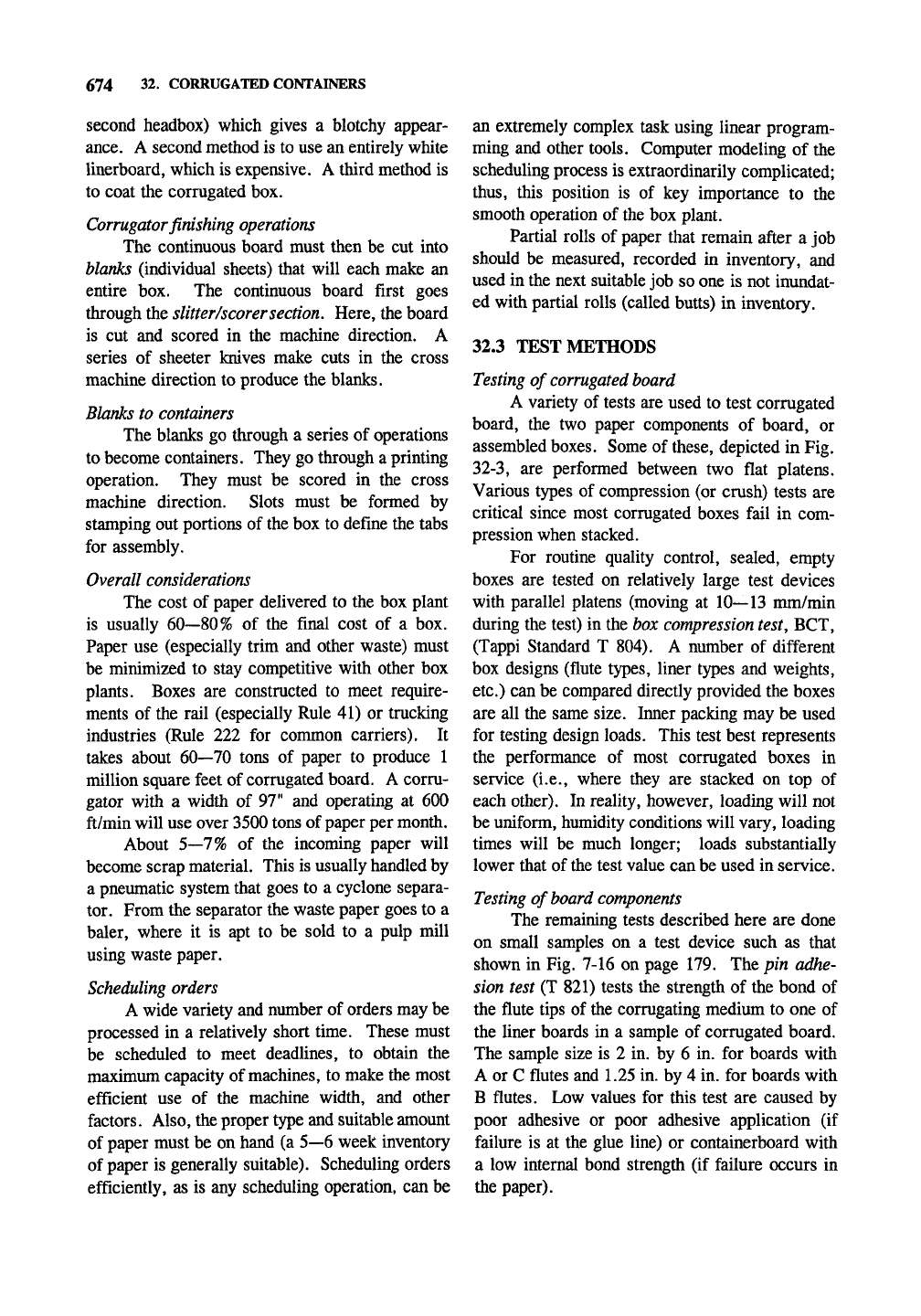
674 32. CORRUGATED CONTAINERS
second headbox) which gives a blotchy appear-
ance.
A second method is to use an entirely white
linerboard, which is expensive. A third method is
to coat the corrugated box.
Corrugator
finishing
operations
The continuous board must then be cut into
blanks (individual sheets) that will each make an
entire box. The continuous board first goes
through the slitter/scorer section. Here, the board
is cut and scored in the machine direction. A
series of sheeter knives make cuts in the cross
machine direction to produce the blanks.
Blanks to containers
The blanks go through a series of operations
to become containers. They go through a printing
operation. They must be scored in the cross
machine direction. Slots must be formed by
stamping out portions of the box to define the tabs
for assembly.
Overall considerations
The cost of paper delivered to the box plant
is usually 60—80% of the final cost of a box.
Paper use (especially trim and other waste) must
be minimized to stay competitive with other box
plants. Boxes are constructed to meet require-
ments of the rail (especially Rule 41) or trucking
industries (Rule 222 for common carriers). It
takes about 60—70 tons of paper to produce 1
million square feet of corrugated board. A corru-
gator with a width of 97" and operating at 600
ft/min will use over 3500 tons of paper per month.
About 5—7% of the incoming paper will
become scrap material. This is usually handled by
a pneumatic system that goes to a cyclone separa-
tor. From the separator the waste paper goes to a
baler, where it is apt to be sold to a pulp mill
using waste paper.
Scheduling orders
A wide variety and number of orders may be
processed in a relatively short time. These must
be scheduled to meet deadlines, to obtain the
maximum capacity of
machines,
to make the most
efficient use of the machine width, and other
factors. Also, the proper type and suitable amount
of paper must be on hand (a 5—6 week inventory
of paper is generally suitable). Scheduling orders
efficiently, as is any scheduling operation, can be
an extremely complex task using linear program-
ming and other tools. Computer modeling of the
scheduling process is extraordinarily complicated;
thus,
this position is of key importance to the
smooth operation of the box plant.
Partial rolls of paper that remain after a job
should be measured, recorded in inventory, and
used in the next suitable job so one is not inundat-
ed with partial rolls (called butts) in inventory.
32.3 TEST METHODS
Testing of
corrugated hoard
A variety of tests are used to test corrugated
board, the two paper components of board, or
assembled
boxes.
Some of these, depicted in Fig.
32-3,
are performed between two flat platens.
Various types of compression (or crush) tests are
critical since most corrugated boxes fail in com-
pression when stacked.
For routine quality control, sealed, empty
boxes are tested on relatively large test devices
with parallel platens (moving at 10—13 mm/min
during the test) in the box compression test, BCT,
(Tappi Standard T 804). A number of different
box designs (flute types, liner types and weights,
etc.) can be compared directly provided the boxes
are all the same size. Inner packing may be used
for testing design loads. This test best represents
the performance of most corrugated boxes in
service (i.e., where they are stacked on top of
each other). In reality, however, loading will not
be uniform, humidity conditions will vary, loading
times will be much longer; loads substantially
lower that of the test value can be used in service.
Testing of board
components
The remaining tests described here are done
on small samples on a test device such as that
shown in Fig. 7-16 on page 179. The pin adhe-
sion test (T 821) tests the strength of the bond of
the flute tips of the corrugating medium to one of
the liner boards in a sample of corrugated board.
The sample size is 2 in. by 6 in. for boards with
A or C flutes and 1.25 in. by 4 in. for boards with
B flutes. Low values for this test are caused by
poor adhesive or poor adhesive application (if
failure is at the glue line) or containerboard with
a low internal bond strength (if failure occurs in
the paper).
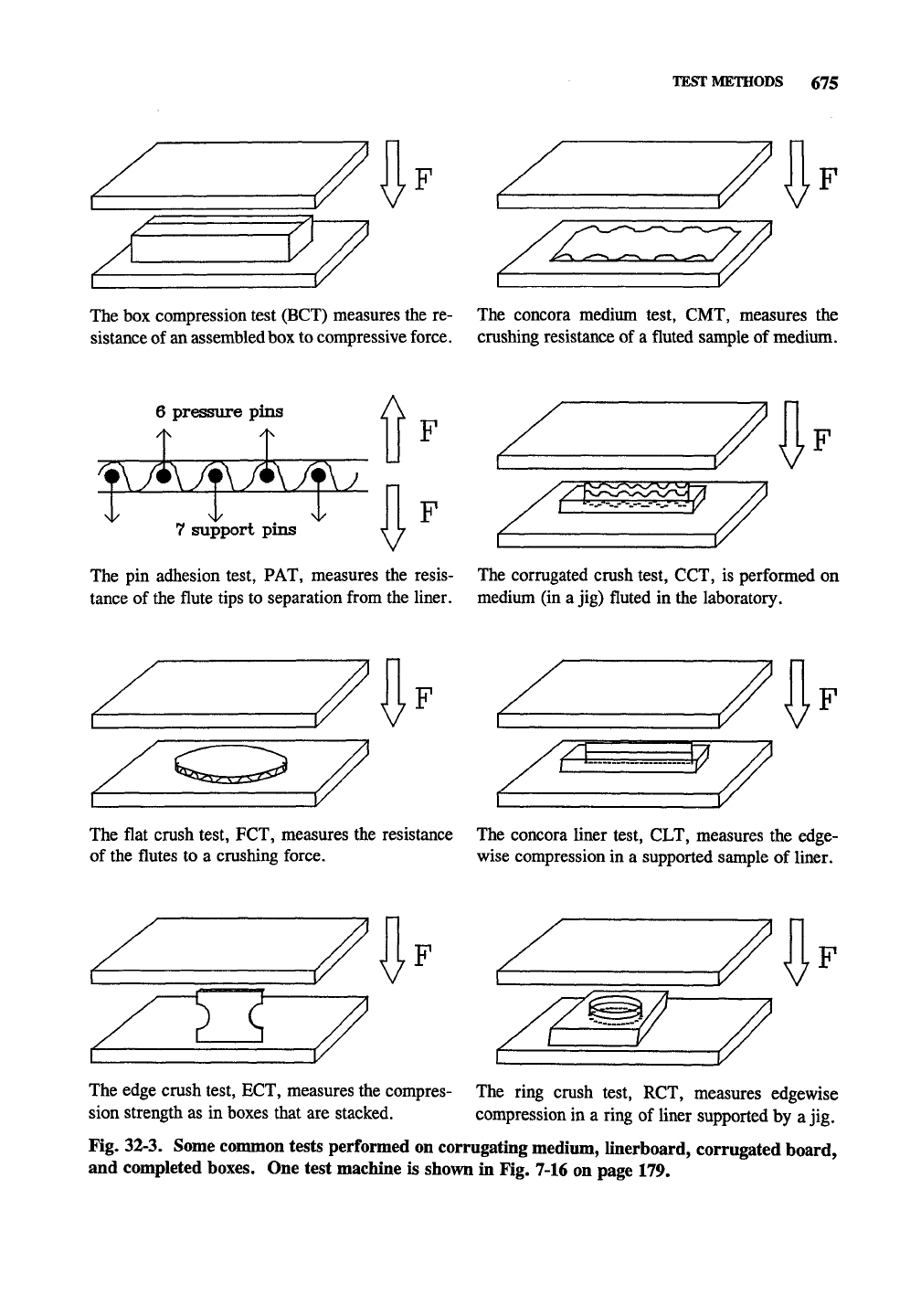
TEST METHODS 675
The box compression test (BCT) measures the re- The concora medium test, CMT, measures the
sistance
of
an
assembled box
to
compressive force, crushing resistance of a fluted sample of medium.
6 pressure pins
A
WMMMMln
7 support pins
V
F
F
The pin adhesion test, PAT, measures the resis- The corrugated crush test, CCT, is performed on
tance of
the
flute tips to separation from the liner, medium (in
a jig)
fluted
in
the
laboratory.
The flat crush test, FCT, measures the resistance The concora liner test, CLT, measures the edge-
of the
flutes
to a crushing force. wise compression in a supported sample of liner.
The edge crush test, ECT, measures the compres- The ring crush test, RCT, measures edgewise
sion strength as in boxes that are stacked. compression in a ring of liner supported by
a
jig.
Fig. 32-3. Some common tests performed on corrugating medium, linerboard, corrugated board,
and completed boxes. One test machine is shown in Fig. 7-16 on page 179.
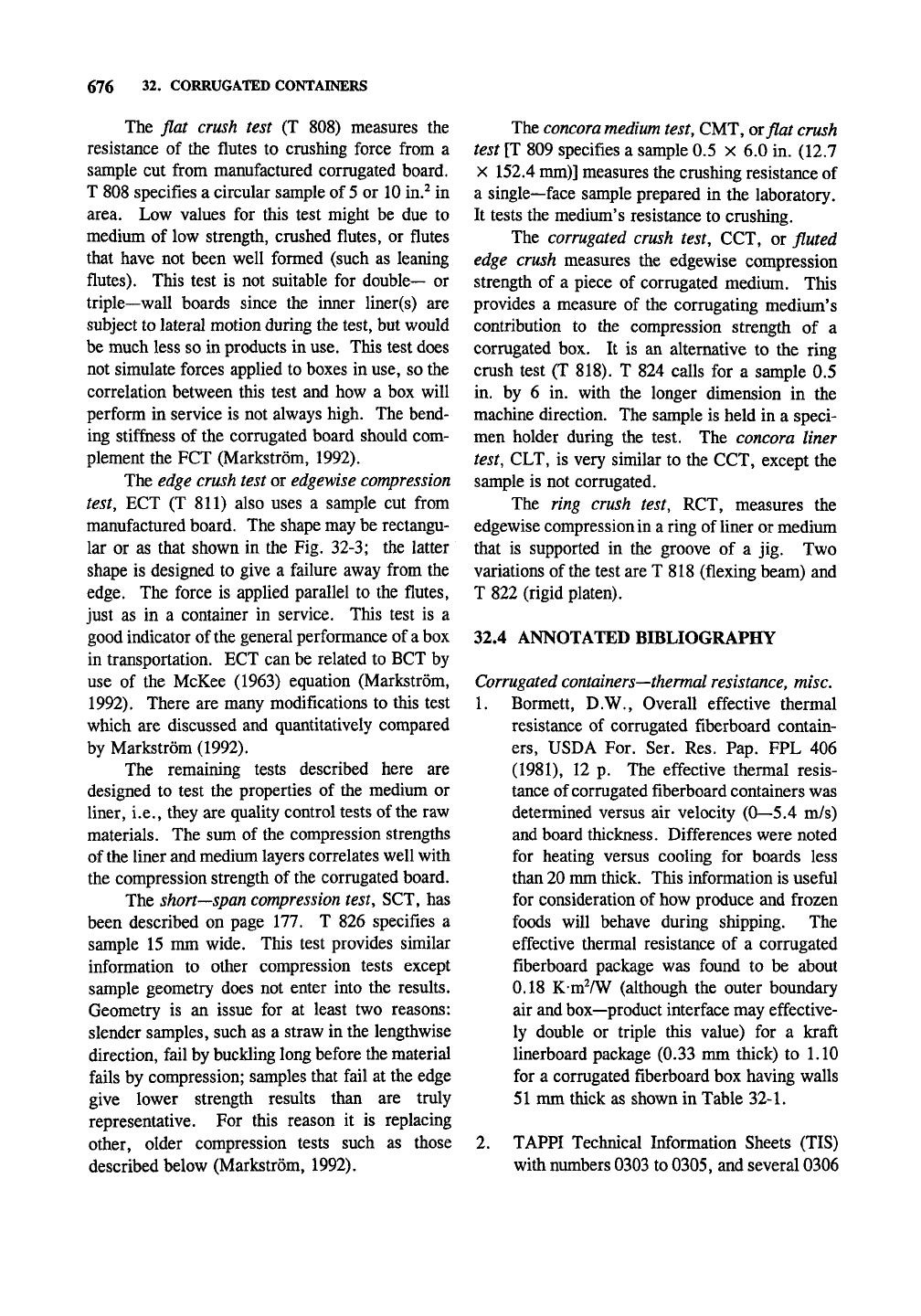
676 32. CORRUGATED CONTAINERS
The flat crush test (T 808) measures the
resistance of the flutes to crushing force from a
sample cut from manufactured corrugated board.
T 808 specifies a circular sample of
5
or 10 in.^ in
area. Low values for this test might be due to
medium of low strength, crushed flutes, or flutes
that have not been well formed (such as leaning
flutes).
This test is not suitable for double— or
triple—wall boards since the inner liner(s) are
subject to lateral motion during the test, but would
be much less so in products in
use.
This test does
not simulate forces applied to boxes in use, so the
correlation between this test and how a box will
perform in service is not always high. The bend-
ing stiffness of the corrugated board should com-
plement the FCT (Markstrom, 1992).
The edge crush test or edgewise compression
test, ECT (T 811) also uses a sample cut from
manufactured board. The shape may be rectangu-
lar or as that shown in the Fig. 32-3; the latter
shape is designed to give a failure away from the
edge.
The force is applied parallel to the flutes,
just as in a container in service. This test is a
good indicator of the general performance of
a
box
in transportation. ECT can be related to BCT by
use of the McKee (1963) equation (Markstrom,
1992).
There are many modifications to this test
which are discussed and quantitatively compared
by Markstrom (1992).
The remaining tests described here are
designed to test the properties of the medium or
liner, i.e., they are quality control tests of the raw
materials. The sum of the compression strengths
of
the
liner and medium layers correlates well with
the compression strength of the corrugated board.
The short—span compression test, SCT, has
been described on page 177. T 826 specifies a
sample 15 mm wide. This test provides similar
information to other compression tests except
sample geometry does not enter into the results.
Geometry is an issue for at least two reasons:
slender samples, such as a straw in the lengthwise
direction, fail by buckling long before the material
fails by compression; samples that fail at the edge
give lower strength results than are truly
representative. For this reason it is replacing
other, older compression tests such as those
described below (Markstrom, 1992).
The
concora medium
test, CMT, or flat crush
test [T 809 specifies a sample 0.5 x 6.0 in. (12.7
X 152.4 mm)] measures the crushing resistance of
a single—face sample prepared in the laboratory.
It tests the medium's resistance to crushing.
The corrugated crush test, CCT, or fluted
edge crush measures the edgewise compression
strength of a piece of corrugated medium. This
provides a measure of the corrugating medium's
contribution to the compression strength of a
corrugated box. It is an alternative to the ring
crush test (T 818). T 824 calls for a sample 0.5
in. by 6 in. with the longer dimension in the
machine direction. The sample is held in a speci-
men holder during the test. The concora liner
test, CLT, is very similar to the CCT, except the
sample is not corrugated.
The ring crush test, RCT, measures the
edgewise compression
in
a ring of liner or medium
that is supported in the groove of a jig. Two
variations of the test are T 818 (flexing beam) and
T 822 (rigid platen).
32.4 ANNOTATED BIBLIOGRAPHY
Corrugated containers—thermal
resistance,
misc,
1.
Bormett, D.W., Overall effective thermal
resistance of corrugated fiberboard contain-
ers,
USDA For. Ser. Res. Pap. FPL 406
(1981),
12 p. The effective thermal resis-
tance of corrugated fiberboard containers was
determined versus air velocity (0—5.4 m/s)
and board thickness. Differences were noted
for heating versus cooling for boards less
than 20 mm thick. This information is useful
for consideration of how produce and frozen
foods will behave during shipping. The
effective thermal resistance of a corrugated
fiberboard package was found to be about
0.18 K-m^/W (although the outer boundary
air and box—product interface may effective-
ly double or triple this value) for a kraft
linerboard package (0.33 mm thick) to 1.10
for a corrugated fiberboard box having walls
51 mm thick as shown in Table 32-1.
2.
TAPPI Technical Information Sheets (TIS)
with numbers 0303 to 0305, and several 0306
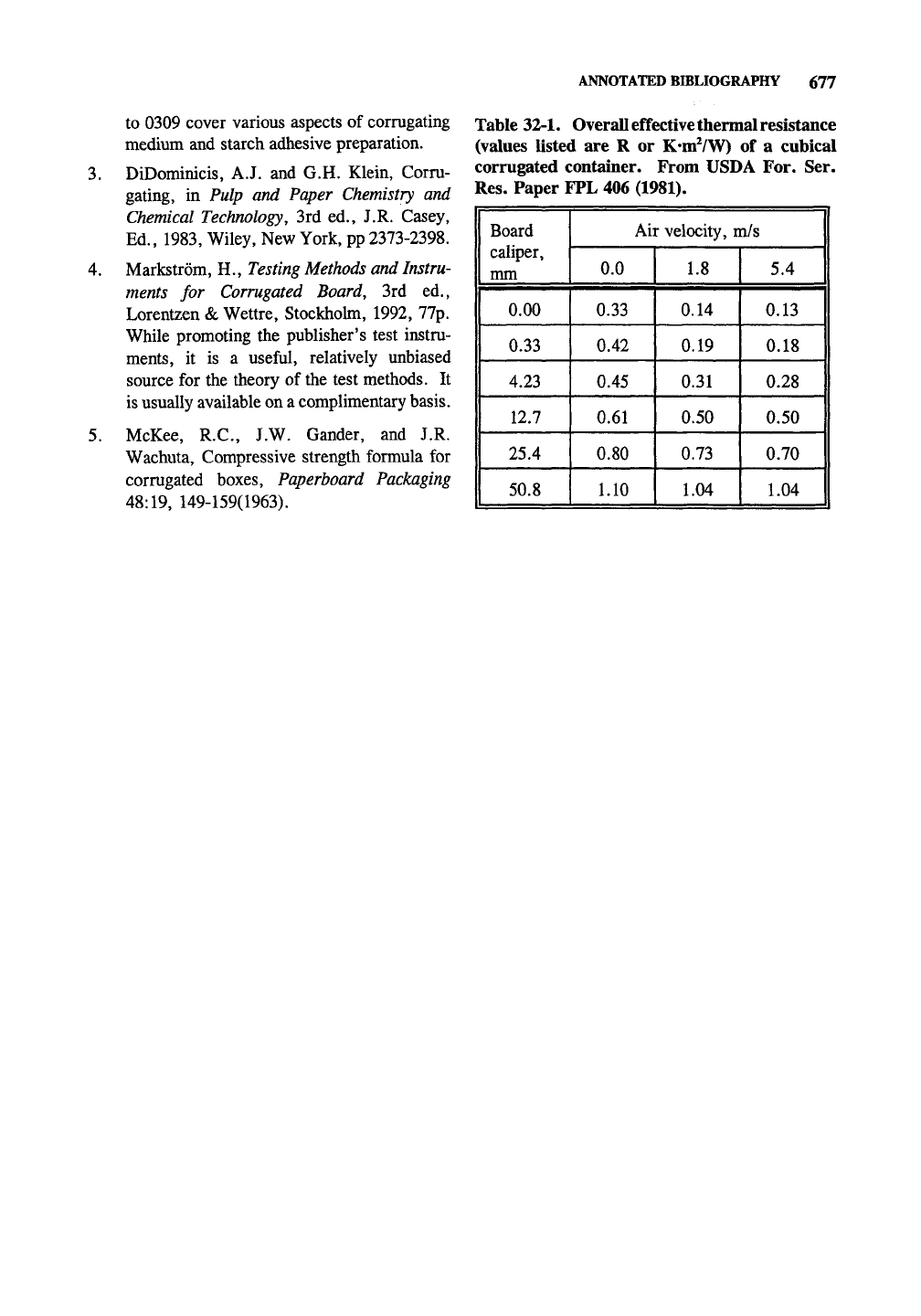
ANNOTATED BIBLIOGRAPHY 677
to 0309 cover various aspects of corrugating
medium and starch adhesive preparation.
3.
DiDominicis, A.J. and G.H. Klein, Corru-
gating, in Pulp and Paper Chemistry and
Chemical Technology, 3rd ed., J.R. Casey,
Ed., 1983, Wiley, New York, pp 2373-2398.
4.
Markstrom, H., Testing Methods and Instru-
ments for Corrugated
Board,
3rd ed.,
Lorentzen & Wettre, Stockholm, 1992, 77p.
While promoting the publisher's test instru-
ments, it is a useful, relatively unbiased
source for the theory of the test methods. It
is usually available on a complimentary basis.
5.
McKee, R.C., J.W. Gander, and J.R.
Wachuta, Compressive strength formula for
corrugated boxes, Paperboard Packaging
48:19,
149-159(1963).
Table 32-1. OveraU effective thermal resistance
(values listed are R or K-m^/W) of a cubical
corrugated container. From USDA For. Ser.
Res.
Paper FPL 406 (1981).
Board
caliper,
1 mm
1
0.00
1
0.33
1
4.23
1
12.7
1
25.4
1
50.8
Air velocity, m/s
0.0
0.33
0.42
0.45
0.61
0.80
1.10
1.8
0.14
0.19
0.31
0.50
0.73
1.04
5.4
1
0.13
1
0.18
1
0.28
1
0.50
1
0.70
1
1.04
1
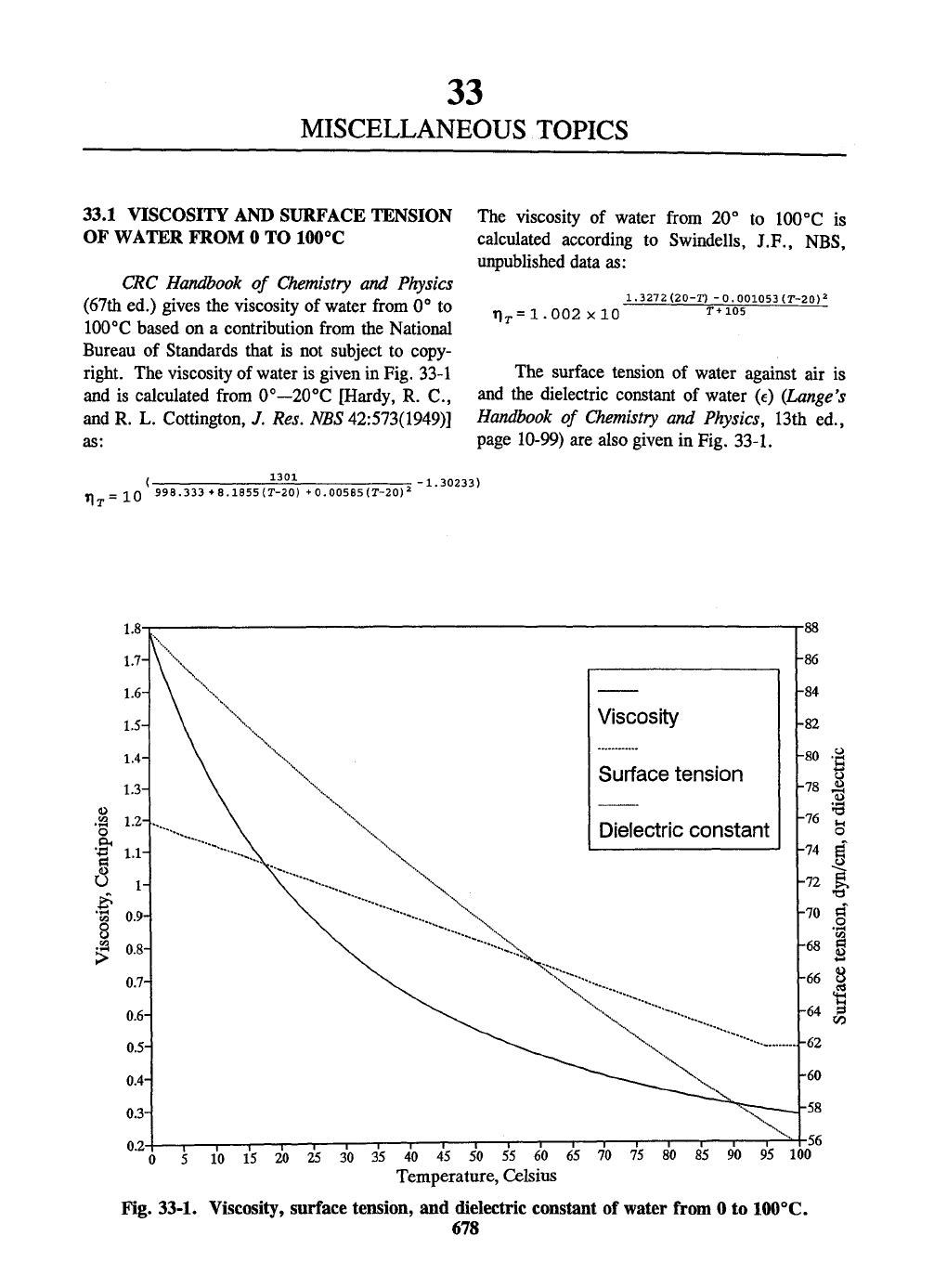
33
MISCELLANEOUS TOPICS
33.1 VISCOSITY AND SURFACE TENSION
OF WATER FROM 0 TO lOO^'C
CRC Handbook of Chemistry and Physics
(67th ed.) gives the viscosity of water from 0° to
100°C based on a contribution from the National
Bureau of Standards that is not subject to copy-
right. The viscosity of water is given in Fig. 33-1
and is calculated from 0°—20°C [Hardy, R. C,
and R. L. Cottington, /. Res, NBS 42:573(1949)]
as:
The viscosity of water from 20° to 100°C is
calculated according to Swindells, J.F., NBS,
unpublished data as:
1.3272(20-T)
- 0.001053(r-20)^
Tly=l. 002X10 ^^105
The surface tension of water against air is
and the dielectric constant of water (e) (Lange's
Handbook of Chemistry and Physics, 13th ed.,
page 10-99) are also given in Fig. 33-1.
^ =10 998.333+8.1855(r-20) +0.00585(r-20)^
-1.30233)
Temperature, Celsius
Fig. 33-1. Viscosity, surface tension, and dielectric constant of water from 0 to
100**
C.
678

VAPOR PRESSURE OF WATER 679
33.2 VAPOR PRESSURE OF WATER FROM 0 TO 280^C
The absolute vapor pressure of water (psia) is shown from 0—100°C (Fig. 33-2) and 100—180°C
(Fig. 33-3). The following equation is useful for calculating the pressure to within 0.05 psi of published
data for 100-~180°C (Handbook of
Chemistry
and Physics, 40th ed., pp. 2328—2330, CRC Co.).
psia = -6.487 + 0.1229 T -h 0.000599566 T" - 0.0000171538 T^ + 0.0000002004133 T^
32F 50F 68F 86F 104F 122F 140F 158F 176F
194F 212F
800
10
20 30
70
80
40 50 60
Temperature, Celsius
Fig. 33-2. Vapor pressure of water from 0 to 100°C.
o
3
212F 248F 284F 320F 356F 392F 428F 464F 500F 536F
•1000
240
/
260
•900
-800
•700
•400
•300
•200
280
100
•0
^
-600 .^
•500
160 180 200 220
Temperature, Celsius
Fig. 33-3. Water vapor pressure as a function of temperature from 100 to 280°C with expanded
scale for pressures below 100 psia.
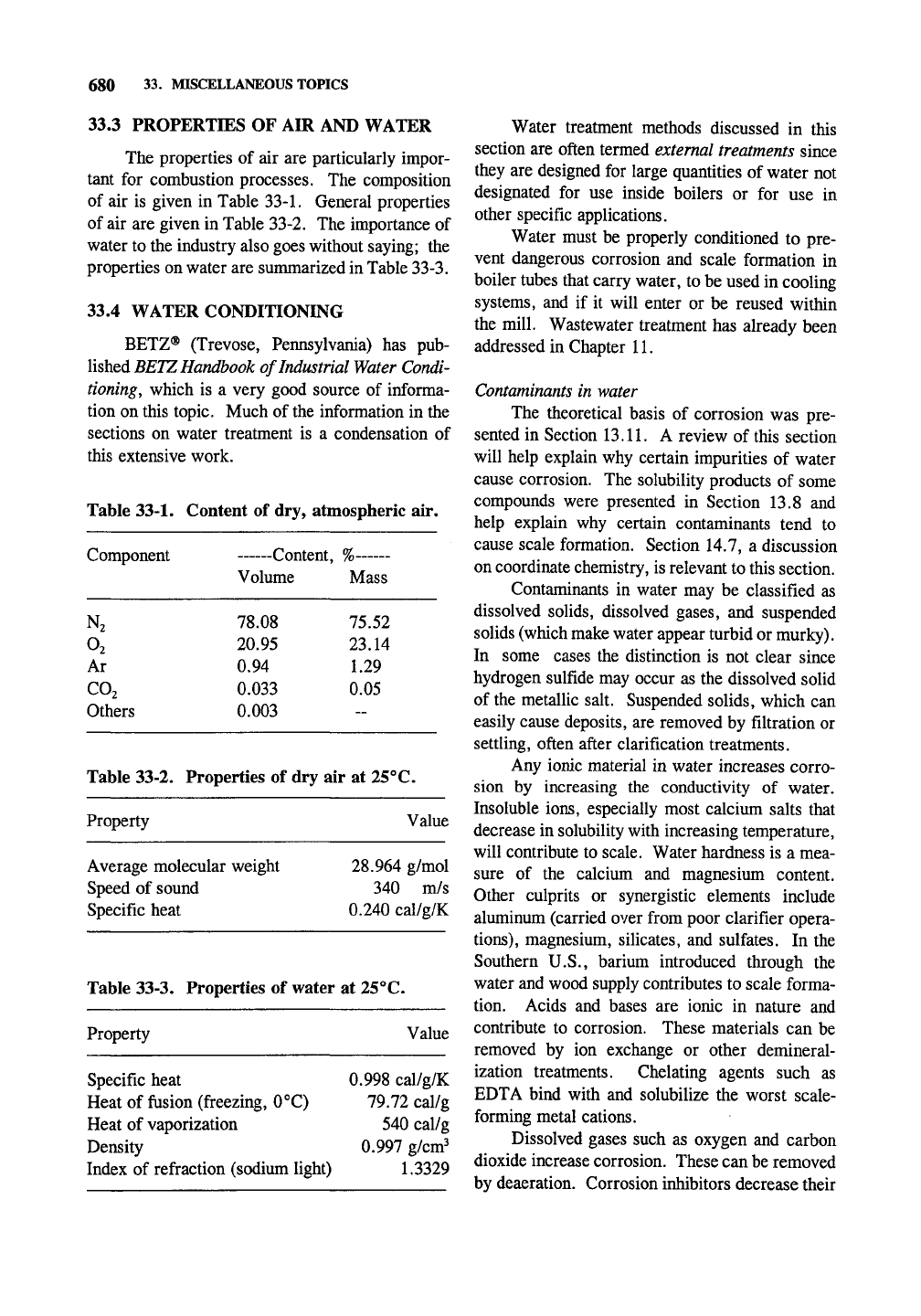
680 33. MISCELLANEOUS TOPICS
33.3 PROPERTIES OF AIR AND WATER
The properties of air are particularly impor-
tant for combustion processes. The composition
of air is given in Table 33-1. General properties
of air are given in Table 33-2. The importance of
water to the industry also goes without saying; the
properties on water are summarized in Table 33-3.
33.4 WATER CONDITIONING
BETZ® (Trevose, Pennsylvania) has pub-
lished BETZ Handbook of Industrial Water Condi-
tioning, which is a very good source of informa-
tion on this topic. Much of the information in the
sections on water treatment is a condensation of
this extensive work.
Table 33-1. Content of dry, atmospheric air.
Component Content,
Volume
Nj 78.08
O2 20.95
Ar 0.94
CO2
0.033
Others
0.003
%
Mass
75.52
23.14
1.29
0.05
Table 33-2. Properties of dry air at 25°C.
Property
Average molecular weight
Speed of sound
Specific heat
Value
28.964 g/mol
340 m/s
0.240
cal/g/K
Table 33-3. Properties of water at 25°C.
Property Value
Specific heat
Heat of fusion (freezing, 0°C)
Heat of vaporization
Density
Index of refraction (sodium light)
0.998
cal/g/K
79.72 cal/g
540 cal/g
0.997
g/cm^
1.3329
Water treatment methods discussed in this
section are often termed external treatments since
they are designed for large quantities of water not
designated for use inside boilers or for use in
other specific applications.
Water must be properly conditioned to pre-
vent dangerous corrosion and scale formation in
boiler tubes that carry water, to be used in cooling
systems, and if it will enter or be reused within
the mill. Wastewater treatment has already been
addressed in Chapter 11.
Contaminants
in water
The theoretical basis of corrosion was pre-
sented in Section
13.11.
A review of this section
will help explain why certain impurities of water
cause corrosion. The solubility products of some
compounds were presented in Section 13.8 and
help explain why certain contaminants tend to
cause scale formation. Section 14.7, a discussion
on coordinate chemistry, is relevant to this section.
Contaminants in water may be classified as
dissolved solids, dissolved gases, and suspended
solids (which make water appear turbid or murky).
In some cases the distinction is not clear since
hydrogen sulfide may occur as the dissolved solid
of the metallic salt. Suspended solids, which can
easily cause deposits, are removed by filtration or
settling, often after clarification treatments.
Any ionic material in water increases corro-
sion by increasing the conductivity of water.
Insoluble ions, especially most calcium salts that
decrease in solubility with increasing temperature,
will contribute to scale. Water hardness is a mea-
sure of the calcium and magnesium content.
Other culprits or synergistic elements include
aluminum (carried over from poor clarifier opera-
tions),
magnesium, silicates, and sulfates. In the
Southern U.S., barium introduced through the
water and wood supply contributes to scale forma-
tion. Acids and bases are ionic in nature and
contribute to corrosion. These materials can be
removed by ion exchange or other demineral-
ization treatments. Chelating agents such as
EDTA bind with and solubilize the worst scale-
forming metal cations.
Dissolved gases such as oxygen and carbon
dioxide increase corrosion. These can be removed
by deaeration. Corrosion inhibitors decrease their

WATER CONDITIONING 681
damage. Oxygen increases pitting and other forms
of corrosion. Carbon dioxide causes corrosion in
steam condensate systems.
A variety of materials cause fairly specific
problems. Ferrous or ferric salts will interfere
with wet end chemistry and decrease the bright-
ness of paper. Ammonia complexes with copper
and zinc alloys, making them soluble. Work in
my laboratory shows that relatively small amounts
of fluoride can decrease rosin sizing with alum.
Aeration
Aeration of water is used to remove dissolved
gases by "dilution" or flushing them away. Since
air contains large amounts of nitrogen and oxygen,
these gases will remain in the water after treat-
ment. Aeration decreases the amount of free CO2
and NH3. Carbonates and ammonium salts,
however, will remain depending upon the pH of
the water. Aeration also precipitates iron as ferric
hydroxide and manganese as manganese dioxide.
Chlorination
Chlorination of water is used to kill microor-
ganisms with adverse health effects. It is used to
produce drinking water. Some mills chlorinate
their water supply in order to decrease the growth
of slime fungi and bacteria. The active species is
hypochlorous acid. The chemistry of chlorine is
covered in Section 17.2. Chlorine is occasionally
used as an oxidant to remove iron and manganese
from water. Chloride, however, causes scale and
corrosion in boilers.
Clarification
Clarification of fresh water is used to prepare
water for domestic and industrial use. Effluent
may also be treated by this method. This method
is used to remove suspended solids by coagulation.
Inorganic salts of aluminum, iron, magnesium, or
silicates can be used. Bentonite (aluminum sili-
cate) is also used. The mechanism involves
colloidal chemistry, which is discussed in detail in
Chapter 21.
Polyelectrolytes, water—soluble polymers
with ionized groups for charge interactions, are
also used. The charged groups may be anionic,
cationic, both cationic and anionic, or only slightly
ionic.
The sludge obtained with polyelectrolytes
tends to be of much lower volume than those
obtained with alum treatment. Low molecular
weight cationic polyelectrolytes (such as
polyamines below 500,000) are used for primary
coagulation. High molecular weight ones (above
20,000,000) are used for flocculation by bridging
particles together. After flocculation, the floes
must be separated from the water by conventional
clarification units.
Filtration
Filtration is used after clarification of water
for drinking or boiler purposes. Water passes
downward through a sand and/or anthracite bed
through a total depth of
40
to 80 cm (15 to 30 in.)
A multilayer gravel bed supports the filtering
media and allows for collection of the filtered
water. These may be gravity or pressure filters.
Do not use cold water to backwash a hot pro-
cess filter since thermal compression and expan-
sion will cause leaks to develop at the flanges and
oxygen in the cold water will cause corrosion.
Precipitation
softening
Water hardness is a measure of
the
amount of
calcium and magnesium present and is reported as
parts per million (as calcium carbonate). Moder-
ate to high hardness water of 150—500 ppm can
be partially softened by precipitation of the offend-
ing species. Calcium and magnesium associated
with bicarbonate anions are termed carbonate or
temporary
hardness since they can be removed by
heating. Calcium and magnesium associated with
chloride or sulfate are termed permanent or
noncarbonate hardness. Lime or sodium
aluminate may be added to raw water to precipi-
tate noncarbonate salts of calcium and magnesium.
This can be done under a variety of conditions
depending upon the quality of the raw water and
the purpose of the treatment.
Cold lime softening uses calcium hydroxide
to precipitate magnesium ions as magnesium
hydroxide. Sodium carbonate is used to precipi-
tate calcium ions as calcium hydroxide. Residual
calcium is about 35 ppm. Since calcium carbonate
and magnesium hydroxide have lower solubility at
high temperatures, hot lime softening can decrease
magnesium to 2 ppm and calcium to 25 ppm.
Ion exchange
Ion exchange resins are used to soften water
by replacing the cations with sodium ions (and

682 33. MISCELLANEOUS TOPICS
possibly the anions with chloride ions) of sodium
chloride. They may also be used to demineralize
water where the cations are replaced by
H"*^
ions
and the anions are replaced by OH" ions.
In 1905 the German chemist Gans used
sodium aluminosilicate materials {zeolites) to
soften water. These materials can absorb calcium
or magnesium cations and liberate sodium ions,
the basis of water softening. The zeolite could be
regenerated by running concentrated NaCl solution
through it to liberate CaClj and MgClj. While
aluminosilicates are seldom used anymore, the
term zeolite softener is occasionally used for any
cationic exchange resin.
In 1944, cationic exchange resins were devel-
oped based on polystyrene crosslinked with about
6—8% divinylbenzene. This resin had a much
higher capacity than previous resins, meaning that
the same volume of resin could exchange many
times more ions than previous materials. In 1948,
the anion exchange analog was developed. Using
these two resins in sequence allows the complete
demineralization of water, instead of merely ex-
changing cations for sodium ions. The
macroreticular anion resins that have discrete
pores are used first in the sequence to remove
organic materials from the raw water that would
otherwise cause fouling of the standard gelular
resins.
Many modifications of the original poly-
styrene divinylbenzene have been made to accom-
plish a wide variety of separations (such as the
determination of molecular weight distributions of
pol5aners described in Section 18.4).
Figure 33-4 shows the structure of poly-
styrene divinylbenzene resin. The functional
groups used in the major types of ion exchange
resins are also showed. In cationic exchange
resins,
the counter anion is tied to the resin and
not free to migrate. Cations in solution can
exchange with the resin cations until all the resin
cations have been exchanged. At this point, a
solution containing the desired cation in relatively
HCzzzCHo
HClZZlCHo
DIVINYL-
BENZENE
MONOMER
FOR CROSS-
UNKING
OH—
CH2-
CH—
CH2-
CH—
CH2-
CH—
CH2-
CH—
CH2-
CK—
CH2-
CH—
CH2-
6 6 6 6 6 6 6
CH—
CH2-
CH—
CH2-
CH—
CH2- CK—
CH2-
CH—
CH2-
CH—
CH2-
CH—
CH2—
6 6 6
CH—CH2-CH—CH2-CH—CH2-CH—CH2-CH—CH2-CH—CH2-CH—CH2—
D] O O
-CH—CH2^
POLYSTYRENE DIVINYLBENZENE BACKBONE
STRONG CATION (SO)
SULFONIC
STRONG ACID
CATION
EXCHANGE
RESIN
R-C00~
K*"
WEAK CATION (WC)
CARBOXYUC
WEAK ACID
CATION
EXCHANGE
RESIN
R'
R N—R'
(R* may be H)
WEAK ANION (WB)
AMMONIUM
WEAK BASE
ANION
EXCHANGE
RESIN
"HOH
CH,
+
I «J n
-N-CH-,
CH
'3 J
0H~
TYPE I STRONG ANION (S
QUATERNARY
AMMONIUM
STRONG BASE
ANION EXCHANGE
RESIN
?"3
+
-N-CH^
OH"
CH2CH2OH
TYPE II STRONG ANION (SB)
QUATERNARY
AMMONIUM
STRONG BASE
ANION EXCHANGE
RESIN
Fig. 33-4. Structures of polystyrene diyinylbenzene ion exchange resins.
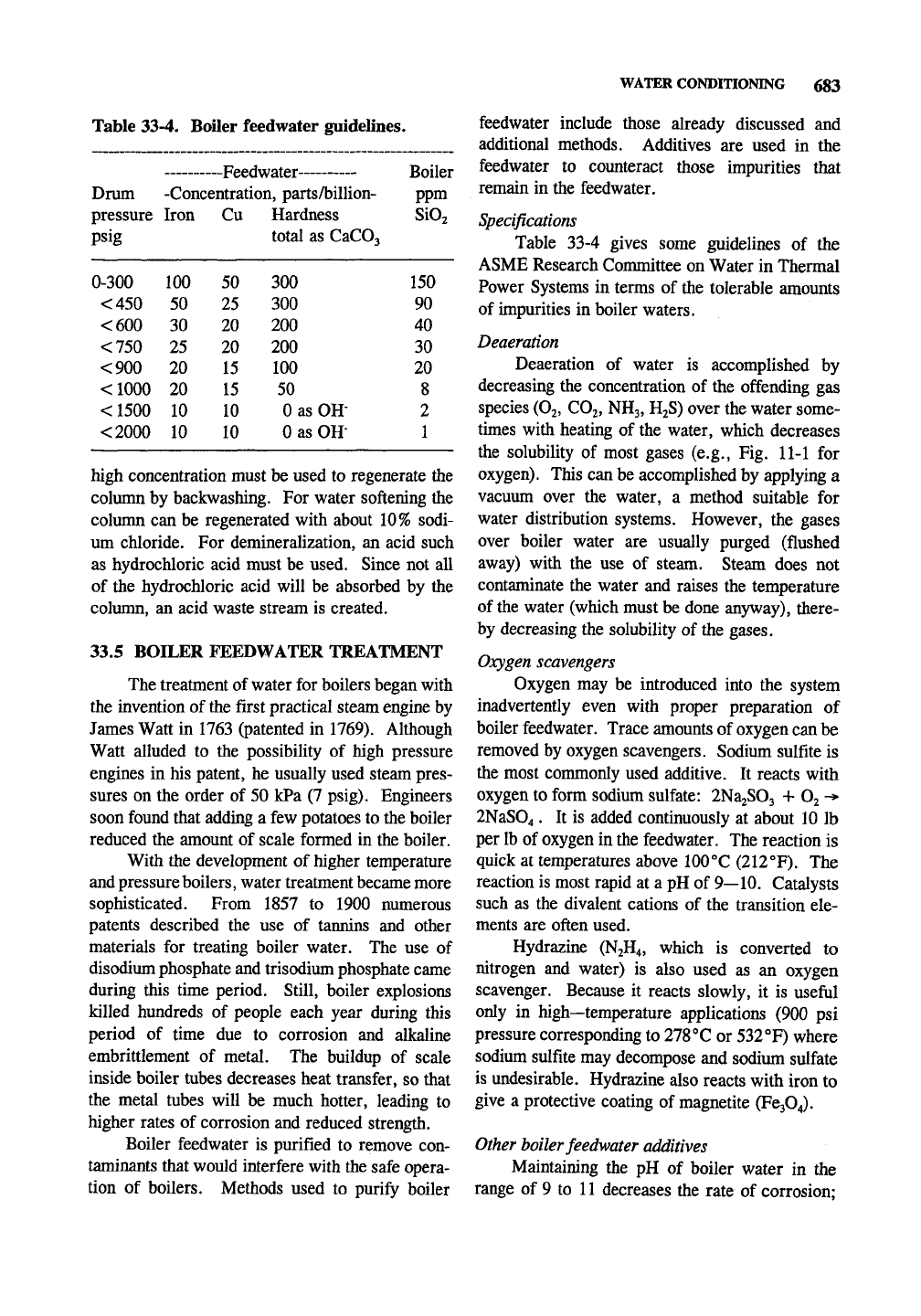
WATER CONDITIONING 683
Table 33-4. Boiler feedwater guidelines.
Drum
pressure
psig
0-300
<450
<600
<750
<900
<1000
<1500
<2000
—Feedwater
-Concentration, parts/billion-
Iron
100
50
30
25
20
20
10
10
Cu Hardness
total as CaCOj
50 300
25 300
20 200
20 200
15 100
15 50
10 0 as OH-
IO 0 as OH"
Boiler
ppm
SiOi
150
90
40
30
20
8
2
1
high concentration must be used to regenerate the
column by backwashing. For water softening the
column can be regenerated with about 10% sodi-
um chloride. For demineralization, an acid such
as hydrochloric acid must be used. Since not all
of the hydrochloric acid will be absorbed by the
column, an acid waste stream is created.
33.5 BOILER FEEDWATER TREATMENT
The treatment of water for boilers began with
the invention of the first practical steam engine by
James Watt in 1763 (patented in 1769). Although
Watt alluded to the possibility of high pressure
engines in his patent, he usually used steam pres-
sures on the order of 50 kPa (7 psig). Engineers
soon found that adding a few potatoes to the boiler
reduced the amount of scale formed in the boiler.
With the development of higher temperature
and pressure
boilers,
water treatment became more
sophisticated. From 1857 to 1900 numerous
patents described the use of tannins and other
materials for treating boiler water. The use of
disodium phosphate and trisodium phosphate came
during this time period. Still, boiler explosions
killed hundreds of people each year during this
period of time due to corrosion and alkaline
embrittlement of metal. The buildup of scale
inside boiler tubes decreases heat transfer, so that
the metal tubes will be much hotter, leading to
higher rates of corrosion and reduced strength.
Boiler feedwater is purified to remove con-
taminants that would interfere with the safe opera-
tion of boilers. Methods used to purify boiler
feedwater include those already discussed and
additional methods. Additives are used in the
feedwater to counteract those impurities that
remain in the feedwater.
Specifications
Table 33-4 gives some guidelines of the
ASME Research Committee on Water in Thermal
Power Systems in terms of the tolerable amounts
of impurities in boiler waters.
Deaeration
Deaeration of water is accomplished by
decreasing the concentration of the offending gas
species
(O2,
COj, NH3, HjS) over the water some-
times with heating of the water, which decreases
the solubility of most gases (e.g., Fig. 11-1 for
oxygen). This can be accomplished by applying a
vacuum over the water, a method suitable for
water distribution systems. However, the gases
over boiler water are usually purged (flushed
away) with the use of steam. Steam does not
contaminate the water and raises the temperature
of the water (which must be done anyway), there-
by decreasing the solubility of the gases.
Oxygen scavengers
Oxygen may be introduced into the system
inadvertently even with proper preparation of
boiler feedwater. Trace amounts of oxygen can be
removed by oxygen scavengers. Sodium sulfite is
the most commonly used additive. It reacts with
oxygen to form sodium sulfate: INajSOj + O2 ->
2NaS04. It is added continuously at about 10 lb
per lb of oxygen in the feedwater. The reaction is
quick at temperatures above 100°C (212°F). The
reaction is most rapid at a pH of 9—10. Catalysts
such as the divalent cations of the transition ele-
ments are often used.
Hydrazine (N2H4, which is converted to
nitrogen and water) is also used as an oxygen
scavenger. Because it reacts slowly, it is useful
only in high—temperature applications (900 psi
pressure corresponding to 278 °C or 532 °F) where
sodium sulfite may decompose and sodium sulfate
is undesirable. Hydrazine also reacts with iron to
give a protective coating of magnetite (Fe304).
Other boiler feedwater additives
Maintaining the pH of boiler water in the
range of 9 to 11 decreases the rate of corrosion;
